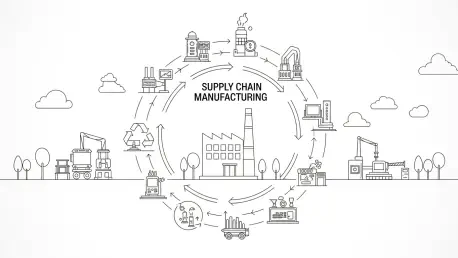In a world where resources are dwindling faster than ever, manufacturers face a pressing challenge: how to keep producing without exhausting the planet’s finite materials while ensuring sustainable growth. Picture a factory not just churning out new products, but systematically reclaiming, refurbishing, and reusing components from old ones, turning waste into a goldmine of opportunity. Circular supply chains—systems designed to maximize resource value through recycling and reuse—are no longer a distant ideal but a critical lifeline for the industry. This exploration dives into the urgency of scaling these models, uncovering the barriers, strategies, and expert insights that can guide manufacturers toward sustainable success.
The Urgency of Circular Systems in Manufacturing
The shift to circular supply chains represents more than an environmental gesture; it’s a strategic pivot for survival in a resource-scarce economy. With raw material costs soaring and climate pressures mounting, companies that fail to adapt risk being left behind. A staggering 95% of executives across 10 industries, as revealed by a comprehensive survey of 491 leaders, believe circularity will be vital to their business within the next three years starting from 2025. This consensus signals a profound transformation, where rethinking waste as a resource becomes a competitive edge.
This urgency isn’t just about compliance or public image—it’s about unlocking economic value. Circular models promise new revenue streams through refurbished goods and stronger customer loyalty by aligning with growing consumer demand for sustainability. The stakes are high, as businesses that master these systems can build resilience against supply chain disruptions and volatile markets, positioning themselves as leaders in an evolving landscape.
Driving Forces Behind the Circular Shift
Beyond the immediate need for resource efficiency, several forces are propelling circularity to the forefront of manufacturing strategy. Climate change regulations are tightening globally, pushing companies to reduce emissions and waste or face hefty penalties. At the same time, the rising cost of virgin materials is squeezing profit margins, making the reuse of existing resources not just eco-friendly but financially sound.
Consumer expectations are also shifting rapidly, with more buyers favoring brands that prioritize sustainability. This trend creates a dual opportunity: meeting market demand while fostering deeper trust and engagement. Additionally, circularity offers a buffer against geopolitical and supply chain uncertainties, allowing manufacturers to rely less on unpredictable raw material imports and more on localized, reusable assets.
Navigating the Obstacles to Scaling Circularity
Scaling circular supply chains is a complex endeavor, riddled with practical hurdles that demand innovative solutions. One significant barrier is managing material returns, as low consumer participation and inconsistent quality of returned goods drive up costs. Partnerships like Renault and Suez’s joint venture, which focuses on recovering materials from end-of-life vehicles, demonstrate how collaboration can address this issue by streamlining collection and recycling processes.
Another challenge lies in consumer hesitancy toward second-hand products, with only 29% and 35% of people purchasing used furniture and clothing, respectively. Companies like Patagonia are countering this through initiatives that offer discounts and quality certifications, gradually building trust in refurbished goods. Infrastructure gaps further complicate the transition, as robust reverse logistics and digital tracking tools are essential for efficiency—firms like Material Mapper are leading the way by using data to enhance transparency in material flows.
Regulatory inconsistencies across regions add another layer of difficulty, often requiring specialized compliance efforts, as seen with HP’s approach to meeting diverse standards for refurbished products. Finally, a skills shortage looms large, with new expertise needed for remanufacturing—organizations like Hitachi are tackling this by creating dedicated units for such tasks. Each of these obstacles requires tailored strategies to ensure scalability without sacrificing quality or profitability.
Expert Perspectives on Circular Transformation
To shed light on the path forward, industry leaders provide critical insights into the state of circularity. Thom Almeida, a key figure in economic systems at a global forum, describes this moment as a “strategic turning point” for manufacturers, emphasizing that circular models are essential for staying competitive. This perspective underscores the need for immediate action rather than gradual adoption, highlighting the broader implications for business growth.
Kyriakos Triantafyllidis, an expert in advanced manufacturing strategies, points to the importance of cross-industry collaboration, noting that no company can scale circularity alone. Supporting this, survey data indicates that 56% of firms adopt hybrid models—blending linear and circular operations—while 80% outsource tasks like collection and dismantling. These authoritative voices, backed by hard data, paint a clear picture: collaboration and adaptability are non-negotiable for success in this space.
Actionable Steps for Building Scalable Circular Systems
For manufacturers ready to embrace circularity, a practical roadmap can turn ambition into reality. Starting with product design, integrating modularity and ease of disassembly ensures materials can be reused efficiently from the outset. This foundational step reduces downstream costs and simplifies the recovery process, setting the stage for scalability.
Strategic partnerships are equally vital, as collaborating with other firms—evident in 80% of companies outsourcing key tasks—helps share expenses and expertise. Investing in infrastructure, such as reverse logistics and digital tools for tracking materials, further enables seamless operations. Meanwhile, boosting consumer trust through incentives and transparent quality guarantees can drive participation in return programs, addressing demand-side challenges.
Lastly, tackling skills gaps by training staff or establishing specialized units, alongside navigating regulatory landscapes with legal support, ensures a holistic approach. These steps, grounded in real-world application, offer manufacturers a clear path to overcome barriers and build systems that not only scale but also deliver lasting economic and environmental benefits.
Reflecting on the Journey to Circularity
Looking back, the journey toward circular supply chains revealed a landscape of both daunting challenges and remarkable innovation. Manufacturers grappled with material returns, consumer skepticism, and regulatory mazes, yet found inspiration in pioneering efforts from industry peers. The insights from experts and data-driven strategies provided a beacon of clarity amidst complexity, showing that transformation was indeed possible.
As the path unfolded, actionable solutions emerged as the cornerstone of progress. Building partnerships, investing in infrastructure, and prioritizing consumer trust stood out as pivotal moves that reshaped operations. For those continuing this journey, the next steps involve deepening collaboration across industries and leveraging technology to predict and manage resource flows more effectively, ensuring that circularity becomes not just a strategy, but a fundamental pillar of manufacturing resilience.









